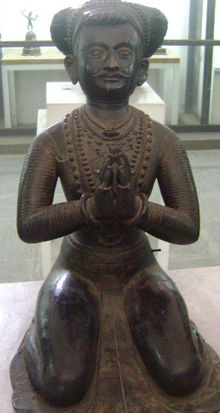Amshuverma
| Amshuverma | |
|---|---|

Statue of Amshuverma at the Chauni Museum, Kathmandu
|
Amshuverma (595-621 AD) rose to the position of Mahasamanta (a position akin to today's prime minister) about 595 AD when King Sivadev I was ruling in the Licchavi kingdom of Nepal. By 604 AD Sivadeva was reduced to a mere figurehead by Amshuverma within years of his appointment as Samanta, a feudal lord. His rule appears to have ended before 621 AD when crown prince Udayadev became King.
Amshuverma is believed to have been a son of a brother of the queen of Sivadeva. He was learned, bold and farsighted ruler of Lichhavi period, he was also a lover of art, architecture and literature. He built Kailashkut Bhawan palace, which became famous as a state of the art palace south of the Himalayas in the seventh century.
The Chinese ambassador Wang Huen Che who was appointed about 640 AD makes a graphic description of its grandeur in Tang Annals of China. The appointment of the Chinese ambassador to the court of Nepal in seventh century shows that a very close relationship pertained between Nepal and China already.
It is believed that Udayadev was exiled to Tibet and the daughter of Udayadev, Bhrikuti, was married to the Tibet Emperor Tsrong-tsing Gompo. This event appears to have opened trade routes between Nepal and Tibet. Some early historians in Nepal had mistakenly concluded that the pictographic symbol used to name the father of Bhrikuti in Tang Annals stood for Amshu (which means the rays of the rising sun in Sanskrit, the language used in Nepal then), where as Udaya (the rise of the sun) would also be written with the same symbols. Bhrikuti could not have been Amshuverma's daughter simply because she would be too old to marry the Chinese Emperor. Bhrikuti was daughter of Udayadev and she had dispatched the Chinese army to Nepal valley to reinstate Narendradev, her brother, as king in Nepal about 640 AD. Bhrikuti was instrumental in spreading Buddhism to Tibet and she later attained the status of Tara, the shakti in Mahayana Buddhism.
The Chinese Buddhist monk Xuanzang, who visited India during the 7th century, described Aṃshuvarmā as a man of many talents. The original temple of Jokhang in Lhasa was modeled after a Nepali monastery design - a square quadrangle with the kwa-pa-dyo shrine at the center of the east wing, opposite to the entrance. The innermost shrine room of the world heritage Jokhang temple still displays the woodwork of Nepali origin and craftsmanship. Since then, and specially after the contributions of Araniko, a Nepali bronze caster and architect, sent to Tibet to cast a stupa in 1265 AD, Nepali art and architecture spread over the countries like China and Japan. An inscription by Aṃshuvarmā dated to 607 AD at Tistung professes the importance of the "Aryan code of conduct" (i.e. the caste system).
...
Wikipedia
